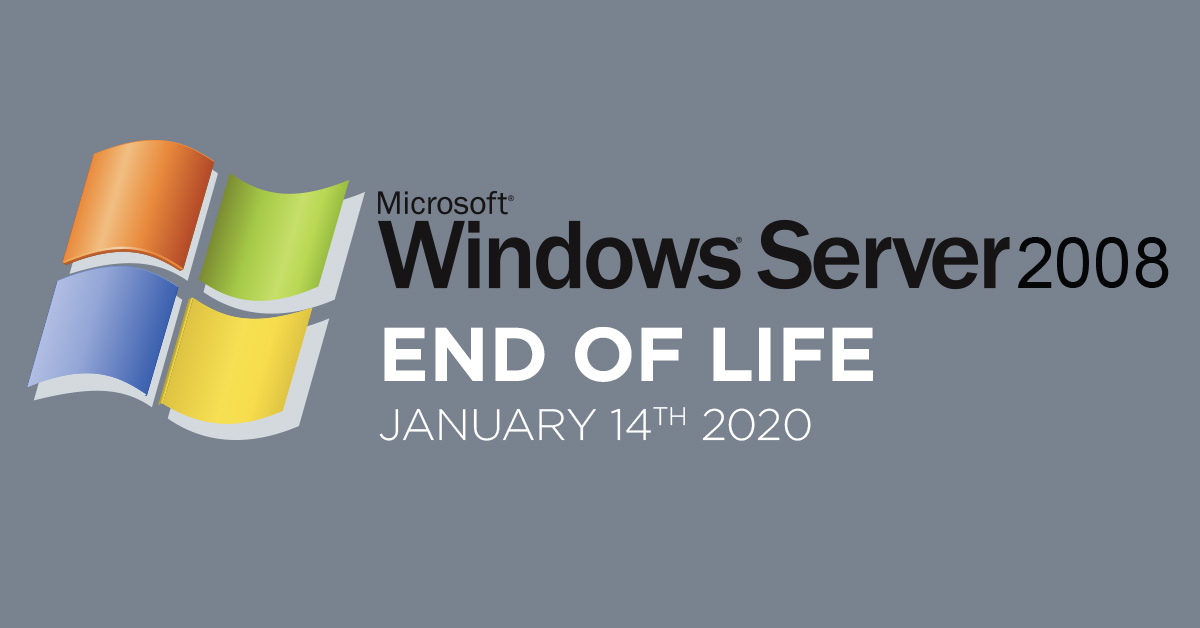-

- Dedicated Hosting
- Cloud hosting
- Services
- Support
- Learning Center
- Referral Program
- Français
-
Why globotech
- Log in


All software have a life cycle. Development companies support their product for a limited period of time. And when time is over, the software is getting “End of life”. This is what just happened with Microsoft Windows Server 2008 and 2008 R2.
Microsoft announced a moment ago the end of support of Windows Server 2008 and Windows Server 2008 R2. This means that in date of January 14 of 2020, there will be no additional:
Any servers running Windows Server 2008 or Windows Server 2008 R2 products won’t be protected anymore. Microsoft will no longer release patch for security issues. And so, any server running Microsoft Windows Server 2008 should be migrated to Microsoft Windows Server 2019.
If you are operating a server running Windows Server 2008 or Windows Server 2008 R2, you should really consider to migrate your content to as new server very shortly.
We invite any or our customer that needs assistance to contact our help desk for assistance with their migration.
Building a website has become critical for jump-starting modern marketing, building company reputations and branding products. Even personal social success is defined by establishing a website or starting a blog to reach like-minded friends and followers in the digital age. Websites are collections of files that you can make accessible to other people across boundaries and borders. Web servers store the information and applications that run on your site, and hosting services make maintaining personal and business websites possible.
WordPress is one of the main forces in today’s Content Management System (CMS) landscape. Created in 2001 and originally named b2/cafelog, it now powers roughly 25% of the web. In order to understand exactly what WordPress is and how it helps, let’s look at how websites were created when WordPress had its early beginnings. We’ll also investigate just how WordPress changed how sites are created in ways that are taken for granted today.
Creating a website in 2001 was like building a house out of raw materials. Writers would begin by opening a new page in an HTML editor, then would paste in the site’s header and footer. If the page was in a subdirectory on the site, they’d create the necessary structure and set up the web server accordingly.
Likewise, designers would access the site via the primitive FTP protocol. Building a website felt less like writing content, and more like structuring files on a remote computer. If webmasters wanted help managing the site, they’d give others access to the directory on the web server. Permission to change content was managed through the operating system’s underlying, confusing permissions mechanism.
By replacing structuring files with managing content, WordPress revolutionized how websites were created. If a writer wanted to create a new post or page, they need only visit their administrative interface and start writing. Instead of following a filesystem layout, content could be organized in ways that fit the current workflow.
Likewise, WordPress segments site collaborators into more meaningful groups. Writers create and publish content, but lack the ability to make technical changes to WordPress’ underlying configuration. Editors can curate content, make minor changes or unpublish posts. Developers might install new plugins and change themes. WordPress empowers content creators by helping them reason about the site they’re creating, and by limiting their actions to those within their area of responsibility.
Content is only one aspect of what makes a good site. Layout is also critical to engaging visitors. Placing an article front and center on a page is useless if attention is drawn into adjacent columns that distract from the message. Similarly, calls to action and other important elements must periodically be added and changed based on business requirements and other factors.
Before WordPress and other CMS gained prominence, themes and site designs were difficult to separate from content. Pages were created by opening templates, adding content, and rarely changing how the site looked. If site designers wanted to change a page’s header, add a new column or update a copyright date, they’d do so by individually editing each page they’d ever created.
WordPress separates the theme, which determines how the site looks, from the site’s content itself. It also separates the site’s general appearance from the building blocks that compose it. As such, it is possible to completely redesign a site with minimal impact on its pages and posts.
Separating content from design has drastically simplified web-based publishing. A rich ecosystem of WordPress professionals has arisen, and the aspiring blogger or business owner can select from any one of thousands of themes for any modern site. Likewise, themes can be created entirely from scratch. If someone can imagine a website, it can be designed and published on WordPress.
While WordPress brought compelling changes to how websites were created, it would not have lasted for longer than a decade without the ability to expand. Plugins empower WordPress to gain new capabilities, enhance existing features, and even to experiment with entirely new ways of managing web content.
The web of 2001 was significantly different than today’s social networks, blogs, sharing models and promotional strategies. Thanks to plugins, WordPress keeps up without losing its stride. WordPress sites can integrate with Twitter for promotion and metrics, store comments on Disqus, and tie into analytics services for rich feedback on website visitors.
WordPress plugins also enable it to serve uses more sophisticated than publishing posts to websites. BuddyPress transforms it into a full social network with activity streams, profiles, user groups and messaging. Likewise, bbPress enables its use as a forum. Creators of membership sites with subscription content would be well served by the Membership 2 plugin. Thousands of available plugins make WordPress one of the best choices for just about any modern website.
After fifteen years, one might think that WordPress has solved all of the problems it launched to fix. This couldn’t be further from the truth.
In late 2015, WordPress announced its new administrative interface called Calypso. The goal was to breathe new excitement into WordPress by addressing many of the issues faced by users of the platform.
For instance, many WordPress users manage large numbers of distinct sites. Calypso supports multiple WordPress instances right out of the box. With access to Calypso, WordPress content creators and designers can manage all of their sites from a single place.
Calypso is also built for speed. Much of the WordPress architecture was designed when the web was more transactional, and changes were served up after submitting a form or clicking Refresh. In contrast, Calypso uses WordPress’ APIs more directly, providing faster access to WordPress internals.
Today’s web is ubiquitous, and content creators must be empowered to create and update using everything from the phone to the desktop. Calypso employs modern responsive web design techniques, transforming WordPress’ venerable administrative interface into one that can keep up with the rapidly changing modern web.
Over the past decade, WordPress changed how websites are created and designed. These advancements ushered in an entire ecosystem of professional designers and developers who, thanks to its extensibility, have helped WordPress to grow alongside the web. Today, its boundaries are still being pushed in ways that keep it relevant and competitive. Anyone wishing to build a compelling, rich website would do well to consider what WordPress has to offer.
Looking to communicate between multiple computers over the network? Conceptually, the way that this is done between two applications can be described using the Open Systems Interconnection model (OSI). (more…)
As most people know, the internet is not infallible. Servers go up and down all the time, due to hardware failure, configuration mistakes, network problems, etc. Many of those failures are often unpredictable and may cause headache to infrastructure owners and administrators. To help counter these potential issues, people have introduced the concept of “High Availability” or HA for short. This whole design philosophy hinges on the replication of network routes and websites data so that there is no single point of failure.
 Looking to create a blog? WordPress is a website Content Management System (CMS) written in PHP that drives what a blog looks like, how users interact with it, and what you do with that blog. It is the most popular CMS out there for bloggers. When you decide to create your own blog, you can either download the software from WordPress.org and host the blog on your servers or create a blog on WordPress.com and not have to worry about software or server maintenance. (more…)
Looking to create a blog? WordPress is a website Content Management System (CMS) written in PHP that drives what a blog looks like, how users interact with it, and what you do with that blog. It is the most popular CMS out there for bloggers. When you decide to create your own blog, you can either download the software from WordPress.org and host the blog on your servers or create a blog on WordPress.com and not have to worry about software or server maintenance. (more…)
To reduce network latency, a Content Delivery Network (CDN) provides a series of alternative servers geographically spread throughout the world. By placing your static images on those servers, they are delivered more quickly, keeping download time to a minimum. In this article, we’ll explore how they work, when to use them, and how they are priced. Ultimately, if they are right for you.
(more…)
Originally developed in collaboration with NASA, OpenStack is an open source project designed to build customizable cloud environments. Although the idea behind OpenStack is simple, the platform itself is not. In this article, we’re going to talk a little bit about how it works and how it can be beneficial to users who are considering using it.
As cyber-crimes and cyber-attacks continue to increase, the need for cyber-security has never been more important. That’s why it has become extremely important to protect our servers as well as our web assets. How should we proceed to establish a secure environment? What are some of the options open to us? There are many ways to ensure the security of your dedicated server, and in this blog entry, we will discuss firewalls, their usage and configuration and which may be best for different applications.